|
Bourne
Valley SSSI
Status
Notified under Section 28 of the
Wildlife and Countryside Act 1981 (as amended)
Part
Local Nature Reserve (LNR) declared under Section 19 of the National
Parks and Access to the Countryside Act 1949 |
|
Local
Planning Authority: Borough of Poole, Dorset County Council
|
National
Grid Reference: SZ 060937
Ordnance
Survey Sheet 1:50 000: 195 |
Area:
72.81 (ha) 179.92 (acres)
1:10,000:
SZ 09 SE, SW |
Date
Notified (Under 1981 Act): 1984 (part), 1985 (part), 1995
Other
Information: The site includes Alder Hill LNR which is managed by the
Dorset Wildlife Trust.
There
are several boundary extensions and exclusions at this notification, and
the Talbot Pit SSSI is also included. |
|
Description
and Reasons for Notification
Bourne
Valley SSSI is part of a complex of heathland sites which together
comprise the Dorset Heathlands. This is one of the major lowland
heathland areas in Britain, with the sites showing a degree of
ecological cohesion and clear ecological trends and patterns. The
heathlands are important in a European and international context for
their plant and animal communities.
The
Bourne Valley site covers the largest tract of heathland that has
survived within the spread of the Bournemouth-Poole conurbation on the
formerly extensive heaths that once bordered Poole Bay. Sequences
of heath, mire and fen woodland vegetation types are well developed and
typical of lowland valley heathland in southern Britain. These
habitats, the Bourne stream and several ponds support a range of rare
and uncommon plants, birds, reptiles and invertebrates. The
assemblage of dragonfly and damselfly species is especially rich.
The
heathland is centred on a deep and narrowly enclosed section of the
Bourne Valley, extending along a 3km length from near the valley head on
the border of Canford Heath. Several other heathland fragments lie
in a adjoining, parallel valley on the south side which is more
extensively developed. Such fragmentation has occurred throughout
the Dorset heaths, with about 86% having been lost since the mid 18th
century. The Bourne Valley contains the only substantially intact
valley heathland that remains along the many deeply incised valleys and
chines leading to Poole Bay.
|
Calluna
vulgaris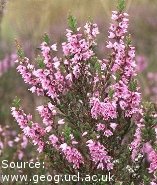
The
valley ridges lie on river terrace deposits of gravels and sands,
probably laid down by an ancient Solent river system during the
Quaternary era. In the valley these deposits have been removed
with the downward cutting of a formerly more substantial Bourne stream,
creating steep slopes on the underlying sands and clayey sands of the
Branksome Sand. This geological history has provided poor and
mostly well drained soils which have favoured the development of dry
heath.
Ulex
gallii and Erica cinerea
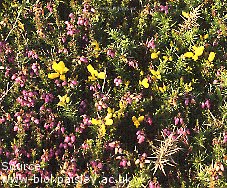 Heather Calluna vulgaris is widely dominant, with
typical associated plants such as bell heather Erica cinerea,
bristle bent Agrostis curtisii, gorse Ulex europaeus and
scattered invasion by Scots pine Pinus sylvestris, birch Betula
species and bracken Pteridium aquilinum. Western gorse Ulex
gallii is also common, a distinctive feature of the Dorset heaths
lying north of Poole Harbour.
Heather Calluna vulgaris is widely dominant, with
typical associated plants such as bell heather Erica cinerea,
bristle bent Agrostis curtisii, gorse Ulex europaeus and
scattered invasion by Scots pine Pinus sylvestris, birch Betula
species and bracken Pteridium aquilinum. Western gorse Ulex
gallii is also common, a distinctive feature of the Dorset heaths
lying north of Poole Harbour.
Where
soil conditions are less dry, typically on the lower slopes, there are
transitions to humid heath characterised by an increased presence of
cross-leaved heath Erica tetralix and purple moor-grass Molinia
caerulea. In places water seepage is more distinct. This
gives rise to wet heath in which these two species gain dominance and
bog mosses such as Sphagnum compactum, heath rush Juncus
squarrosus and deergrass Trichophorum cespitosum can also
occur.
 Other
flushes have a different character, supporting for
example, bog pimpernel Anagallis tenella, common yellow-sedge Carex
demissa and southern marsh-orchid Dactylorhiza praetermissa (left),
indicative of slightly base-rich water. Other
flushes have a different character, supporting for
example, bog pimpernel Anagallis tenella, common yellow-sedge Carex
demissa and southern marsh-orchid Dactylorhiza praetermissa (left),
indicative of slightly base-rich water.
A
mostly abrupt fall of the valley slopes to a flat valley bottom creates
sharp transitions to mosaics and zonations of wet heath, mire, bog pool
and fen woodland vegetation types. Drainage is poor and there is
seasonal inundation from the accumulation of ground water. Much of
this land is dominated by tussocky expanses of purple moor-grass more
containing prominent stands of bog-myrtle Myrica gale. In
other areas and around small pools there is a more species rich valley
mire vegetation. This is characterised by a variety of bog mosses
including Sphagnum magellanicum and the nationally scarce S.
pulchrum, and other plants such as bog asphodel Narthecium
ossifragum, white beak-sedge Rhynchospora alba and
oblong-leaved sundew Drosera intermedia. The bog pool
vegetation includes bog pondweed Potamogeton polygonifolius and
lesser bladderwort Utricularia australis.
Alongside
much of the Bourne stream, through the middle of the valley bottom, the
heathland is divided by a belt of fen woodland. Birch species
occur on the better drained ground and scrub willow Salix species
dominate where there is waterlogging. The ground flora is varied,
ranging from purple moor-grass mire to nutrient enriched fen vegetation
that includes meadow sweet Filipendula ulmaria, gipsywort Lycopus
europaeus and marsh woundwort Stachys palustris.
The
stream is the most significant in size and length within the Dorset
heaths. Some stretches are shallow, gravelly and fast flowing,
others are deeper and sluggish. Several ponds along its length
support swamp communities comprising species such as bulrush Typha
latifolia, branched bur-reed Sparganium erectum and common
spike-rush Eleocharis palustris.
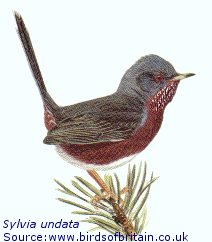 The
site supports a distinctive heathland fauna with a broad range of the
rarer species characteristic of the Dorset heaths. Among the
breeding
birds are the rare Dartford warbler Sylvia undata1,3
(left), stonechat Saxicola torquata (below) - a species showing a major decline
in its British breeding distribution - and nightjar Caprimulgus
europaeus1. The
site supports a distinctive heathland fauna with a broad range of the
rarer species characteristic of the Dorset heaths. Among the
breeding
birds are the rare Dartford warbler Sylvia undata1,3
(left), stonechat Saxicola torquata (below) - a species showing a major decline
in its British breeding distribution - and nightjar Caprimulgus
europaeus1.
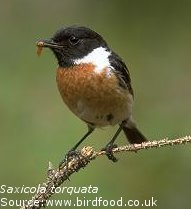 All six British reptile species
are
present. The endangered and specially protected sand lizard Lacerta
agilis2 (below) occurs widely on the heathland slopes and there
are several populations of smooth snake Coronella austriaca2,
also an endangered and specially protected species. All six British reptile species
are
present. The endangered and specially protected sand lizard Lacerta
agilis2 (below) occurs widely on the heathland slopes and there
are several populations of smooth snake Coronella austriaca2,
also an endangered and specially protected species.
The
invertebrates of the heathland are less well
studied but records of nationally rare and scarce species from several insect
groups indicate the presence of a significant interest. These
include species of Orthoptera such as the nationally rare grasshopper Chorthippus
vagans and the nationally scarce bog bush-cricket Metrioptera
brachyptera; Lepidoptera such as silver-studded blue Plebejus
argus (below) and dark tussock moth Dicallomera fascelina, both
nationally scarce species; Hymenoptera such as the nationally scarce
hairy sand wasp Podalonia hirsuta and nationally rare Diptera
species such as a bee fly Thyridanthrax fenestratus and a
parasitic fly Myopa fasciata.
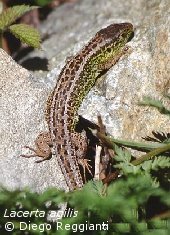 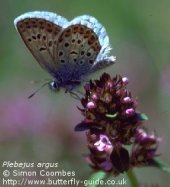 The
site is particularly significant for a rich a diverse assemblage of
dragonflies
and damselflies. More than 20 species have been recorded, at
least 18 with breeding evidence, and this reflects the variety of
aquatic habitats and terrestrial feeding habitats. A few species
use the acidic bog pools and wet heath seepages, notably keeled skimmer Orthetrum
coerulescens and small red damselfly Ceriagrion tenellum
which is nationally scarce. For others, including golden-ringed
damselfly Cordulegaster boltonii and large red damselfly Pyrrhosoma
nymphula, the Bourne stream provides breeding habitat. The
less acidic and well vegetated ponds support the largest and most
diverse faunas with species such as the nationally scarce downy emerald Cordulia
aenea and the local black-tailed skimmer Orthetrum cancellatum.
The swamp vegetation of these ponds is also of interest for several rare
and local reed beetle Donacia species. The
site is particularly significant for a rich a diverse assemblage of
dragonflies
and damselflies. More than 20 species have been recorded, at
least 18 with breeding evidence, and this reflects the variety of
aquatic habitats and terrestrial feeding habitats. A few species
use the acidic bog pools and wet heath seepages, notably keeled skimmer Orthetrum
coerulescens and small red damselfly Ceriagrion tenellum
which is nationally scarce. For others, including golden-ringed
damselfly Cordulegaster boltonii and large red damselfly Pyrrhosoma
nymphula, the Bourne stream provides breeding habitat. The
less acidic and well vegetated ponds support the largest and most
diverse faunas with species such as the nationally scarce downy emerald Cordulia
aenea and the local black-tailed skimmer Orthetrum cancellatum.
The swamp vegetation of these ponds is also of interest for several rare
and local reed beetle Donacia species.
English
Nature, Dorset Team, 14 March 1995
1
Species listed in Annex 1 of the
EC Birds Directive
2
European protected species listed
in Schedule 2 of Habitats Regulations 1994
3
Specially protected species listed
in Schedule 1 of the Wildlife Countryside Act 1981

|